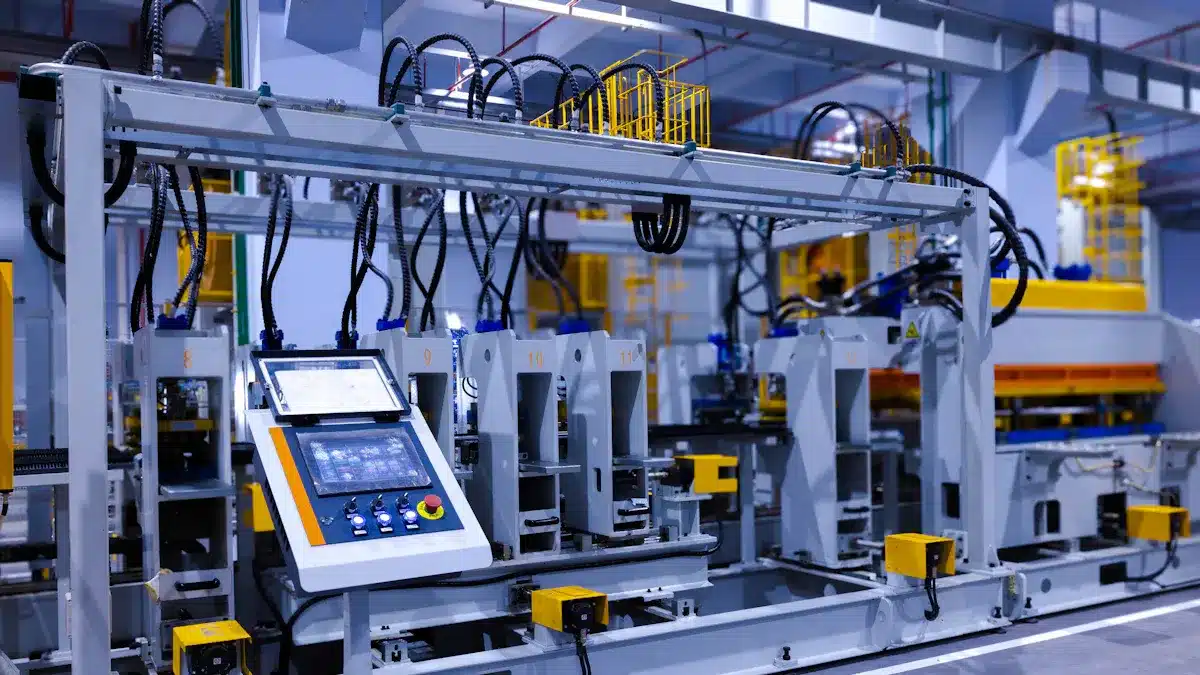
Artificial Intelligence (AI) is transforming the field of manufacturing electronics. It enables manufacturers to operate more efficiently and quickly. AI streamlines production processes and reduces delays. Quality control improves as AI analyzes data to minimize errors in design and production. Additionally, AI supports sustainability efforts by enhancing supply chains, reducing waste, and optimizing energy use. Currently, experts predict that the global AI in manufacturing market could reach approximately USD 155.04 billion by 2030, highlighting the significant role AI plays in the manufacturing electronics industry.
Key Takeaways
AI helps find problems early. This reduces mistakes made by people. It makes products more dependable.
Smart manufacturing uses AI to make production faster. It also tracks shipping and keeps quality the same. This saves time and money.
3D printing makes it quicker to create models. It cuts costs and helps teams work together better. This leads to faster product launches.
AI helps save energy and cut down waste. This allows manufacturers to take care of the environment.
New trends like advanced circuit packaging and flexible electronics use AI. They create devices that are smaller, faster, and smarter.
AI and Quality Control

Automated Inspection
Automated inspection systems are very important for quality control in electronics manufacturing. These systems use advanced machine vision technology. They can find defects that human inspectors might miss. Some common AI-powered inspection systems are from Keyence and Cognex. They use industrial cameras for basic checks. Other AI systems, like Instrumental’s platform, use machine learning algorithms. These algorithms get better over time. They can find both known and new defects well.
For example, a study on telecommunications equipment showed that Instrumental’s AI found 4.6% of defects. These were defects that three human inspectors missed during a final check. This shows how AI improves quality and efficiency. AI can achieve recall rates in the 80s and 90s percent, which is often better than humans. Using AI in inspections not only helps find defects but also improves traceability. This helps fight counterfeits and keeps manufacturers’ standards high.
Big companies in electronics, like Intel and Samsung, use AI-driven inspection technologies. These technologies help find tiny defects and improve production quality. For instance, Intel uses AI for wafer inspection. This makes semiconductors more reliable. Samsung also uses machine vision for PCB and soldering inspections. This shows that AI is effective in reducing product defects.
Predictive Maintenance
Predictive maintenance is another way AI helps quality control in electronics manufacturing. This method involves watching equipment with IoT sensors. These sensors collect real-time data on things like vibration and temperature. AI looks at this data to find early signs of wear or problems that could cause equipment failure.
By using predictive maintenance, manufacturers can plan repairs ahead of time. This helps avoid unexpected breakdowns. For example, a global car manufacturer increased machine uptime by 20%. They did this by finding small problems early and scheduling maintenance. Even though this example is from the car industry, the ideas work for electronics manufacturing too. By moving from reactive maintenance to AI-powered predictive maintenance, manufacturers can keep operations running smoothly and reduce costly problems.
Manufacturing Electronics Efficiently

Smart Manufacturing
Smart manufacturing is changing how electronics are made. It uses AI to make production better. Some important parts of smart manufacturing are:
Rapid Prototyping: AI helps with circuit layout and placing parts. This saves time and speeds up product design.
Predictive Quality Control: AI monitors production and checks images to find defects early. This keeps production quality steady.
Logistics Tracking: AI gives real-time updates on shipments. This helps manufacturers spot supply chain problems and keep production going.
Smart manufacturing has a big impact. For example, AI vision systems in semiconductor production find defects with over 98% accuracy. This lowers rework and helps achieve zero defects. BMW used AI for visual checks and cut defect rates by 32%. They also reduced inspection time by 28%. These changes boost production without losing quality.
Supply Chain Optimization
AI is also very important for improving supply chains in electronics manufacturing. It helps with predicting demand, managing inventory, and buying supplies. This keeps stock levels right and cuts down waste. Some key benefits are:
Improved Lead Time Sensing: AI systems help avoid running out of stock or having too much. They turn demand forecasts into clear plans for buying and making products.
Faster Decision-Making: AI can respond quickly to market changes. This helps finish and deliver goods on time.
Enhanced Resilience: AI can predict problems and change sourcing and production plans as needed.
Companies using AI in their supply chains see real improvements. For instance, deep learning models cut forecasting errors by about 84-87% compared to older methods. This accuracy helps lower working capital needs and cut costs.
3D Printing Speeds Up Prototyping
Development Efficiency
3D printing makes development faster in electronics manufacturing. This technology quickly turns digital designs into real models. Manufacturers can change designs quickly and test them early. Here are some important benefits of 3D printing in development:
Fast Iterations: Designers can find mistakes early. This reduces errors and speeds up new products.
Improved Collaboration: Physical prototypes help designers, engineers, and marketing teams work together. This improves communication and decision-making.
Market Validation: Companies can show real prototypes to customers and investors. This feedback helps meet market needs better.
Cost Reduction: 3D printing cuts costs, especially for startups. It allows faster presentations and changes without big investments.
Overall, 3D printing helps make better decisions and lowers errors. This is important for innovation in electronics.
Rapid Prototyping
Rapid prototyping with 3D printing is key to speeding up product development. This process shortens lead times from weeks or months to just hours or days. Here are some benefits of rapid prototyping:
Cost Efficiency: It removes the need for expensive tools and special workers. This makes prototyping cheaper.
Ease of Use: Non-specialists can use 3D printers easily. This reduces the need for machinists and complex logistics.
Flexibility: Different 3D printing methods, like SLA and FDM, allow for many types of prototypes. These can be pretty models or working parts.
Consistency: Prototyping and production can happen on the same platform. This ensures quality and reliability.
These benefits lead to faster time-to-market and better development processes in electronics manufacturing. As a result, 3D printing speeds up prototyping. This helps manufacturers adjust quickly to changing market needs.
Sustainability Takes Center Stage
Energy Efficiency
Energy efficiency is very important in electronics manufacturing. AI technologies help manage energy better in factories. Manufacturers can use different AI strategies to save energy:
AI systems check energy use to find and fix problems, which cuts down on energy waste.
AI automation and machine vision help with quality checks and process control, making production better and reducing mistakes.
Predictive maintenance uses sensor data and AI to predict equipment failures. This helps avoid downtime and saves energy by using equipment wisely.
Using AI from the design stage through generative design and simulation helps make products easier to manufacture and cuts down on material waste, which also saves energy.
Planning focuses AI efforts on areas that can save the most energy, making sure resources are used wisely.
Regularly checking and updating AI models helps keep energy efficiency high over time.
These strategies lower energy costs and make manufacturing more sustainable. By focusing on energy efficiency, manufacturers can cut their carbon footprint and support eco-friendly designs.
Waste Reduction
Waste reduction is another key part of sustainability in electronics manufacturing. AI techniques are changing how manufacturers handle waste. Smart robots can take apart electronic devices to find and sort parts for recycling. This helps recover valuable metals and rare earth elements. Also, smart cameras and sensors on conveyor belts can accurately identify and sort materials like metal alloys and plastics. This technology boosts recycling rates and greatly reduces waste.
Advanced methods like hyperspectral imaging help improve material sorting in complicated electronic waste. These new ideas make sorting more accurate and help recover resources. AI waste management helps lessen environmental impact by improving the analysis, monitoring, and handling of harmful pollutants. Techniques like Life Cycle Assessment (LCA), Multi-Criteria Analysis (MCA), and Extended Producer Responsibility (EPR) are used with AI to make e-waste processing, recycling, and disposal better. This supports circularity and cuts down on toxic emissions.
AI models offer real-time monitoring and risk assessment, helping to avoid environmental problems and improve safety. These AI methods encourage eco-design, proper processing, and reuse of electronic materials. Together, they help reduce material waste and harm to the environment. While the evidence is more about concepts and models than exact numbers, it shows AI’s ability to improve resource circularity and environmental planning in managing electronic waste.
Emerging Electronics Manufacturing Trends
Advanced Circuit Packaging
Advanced circuit packaging is very important for changing electronics manufacturing. New techniques include:
3D IC packaging: This stacks circuits on top of each other. It improves performance and saves space.
Fan-out packaging: This allows more connections in a small area. It makes things work better.
Chiplet packaging: This combines different chips into one package. It helps the parts communicate better.
These new ideas meet the need for smaller, better, and cheaper solutions in the semiconductor field. But there are still challenges, like needing standard rules and new ways to handle these packages. New materials, like polymeric and nano-functional composites, are important for improving electronic packaging.
These advanced methods have a big impact. They help chips talk to each other, make things faster, and allow for smaller designs. For example, additive manufacturing lets circuits be printed layer by layer. This cuts costs and waste. Flexible hybrid electronics (FHE) are also becoming popular, especially for wearables and aerospace, where light and flexible designs are very important.
Flexible Electronics
Flexible electronics are another exciting trend in the electronics world. Current advancements include:
Wearable health devices: These are patches and implants that track health data.
Printed electronics: New manufacturing methods are changing how circuits are made.
Eco-friendly designs: Companies are making biodegradable circuits to help the environment.
Key industries using flexible electronics are healthcare, consumer electronics, and cars. The Asia-Pacific area leads this market because of the demand for foldable smartphones and wearables. North America is ahead in research and development, especially in healthcare and defense.
The use of IoT and 5G is changing production. It allows connected devices to communicate easily. Industry 4.0 technologies, like AI and real-time data analysis, improve efficiency and cut waste. These advancements create smart factories, helping manufacturers quickly adjust to market changes.
AI greatly affects electronics manufacturing trends by making things work better, improving quality, and being more eco-friendly. Here are some important areas where AI helps:
Quality Control: AI finds defects better and cuts down on mistakes made by people.
Supply Chain Management: AI helps manage stock and predict needs, so manufacturers can react to market changes.
Sustainability: AI helps save energy and reduce waste.
Still, there are challenges like complicated supply chains and problems with data quality. There are chances to improve planning and manage workers using AI. Experts suggest that manufacturers should use AI in all parts of their work, especially in predictive maintenance and quality control systems. This smart plan will help them deal with changes in the industry.
Readers are invited to share their thoughts or questions about how AI is used in electronics manufacturing.
FAQ
What is the role of AI in electronics manufacturing?
AI makes electronics manufacturing better by increasing efficiency, quality, and sustainability. It automates tasks, improves quality checks, and helps manage supply chains. This leads to faster production and less waste.
How does AI improve quality control?
AI helps quality control with automated inspection systems and predictive maintenance. These tools find defects early and stop equipment failures. This keeps product quality steady.
What are the benefits of smart manufacturing?
Smart manufacturing uses AI to make production smoother. It allows for quick prototyping, checks quality ahead of time, and tracks logistics in real-time. This results in better efficiency and lower costs.
How does 3D printing impact prototyping in electronics?
3D printing speeds up prototyping by allowing fast changes and updates. It cuts costs and improves teamwork among groups. This leads to quicker launches of new products.
Why is sustainability important in electronics manufacturing?
Sustainability matters in electronics manufacturing to lessen environmental harm. AI helps save energy and cut waste, supporting eco-friendly methods and following rules.
See Also
Emerging Innovations Shaping PCB And PCBA Design Processes
The Critical Role Of Custom PCBA In Today’s Electronics
How PCBA Manufacturing Skills Impact Electronics Design Success
PCBA Technology Elevating The Future Of Modern Electronics
Effective Strategies To Overcome PCBA Manufacturing Challenges